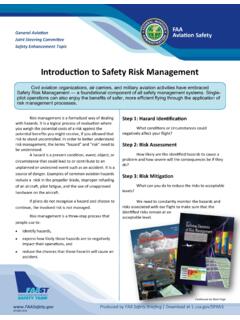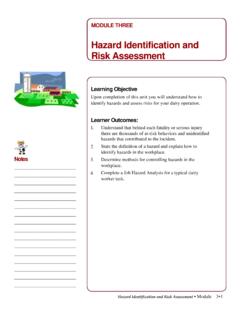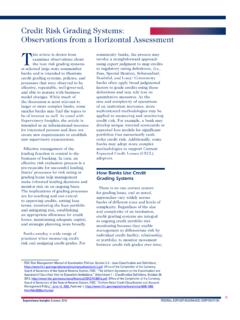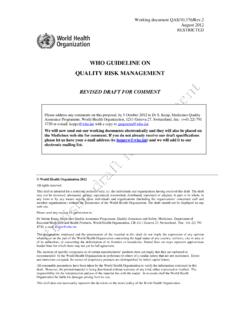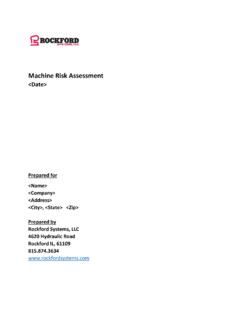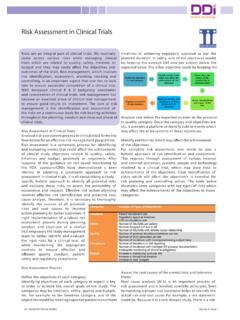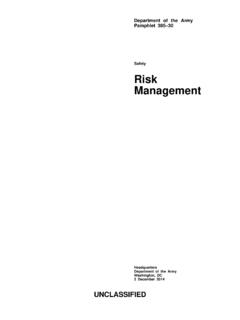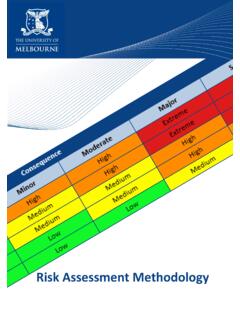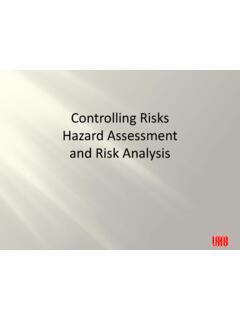Transcription of RISK MANAGEMENT
1 FAO FOOD AND NUTRITION PAPERNUMBER 65 RISKMANAGEMENTANDFOOD SAFETYR eport of a Joint FAO/WHO ConsultationRome, Italy, 27 to 31 January 1997 ISSUED BY THEFOOD AND AGRICULTURE ORGANIZATIONOF THE UNITED NATIONSIN COLLABORATION WITH THEWORLD HEALTH ORGANIZATIONROME, 1997 The designation employed and the presentation of material in this publication do not imply theexpression of any opinion whatsoever on the part of the Food and Agriculture Organization ofthe United Nations concerning the legal status of any country, territory, city or area or of itsauthorities, or concerning the delimitation of its frontiers or issued in March 1997 in PDF format: reissued in April 1997 with copyright in this document is vested in the Food and Agriculture Organization of the UnitedNations.
2 Application for permission to reproduce this book, in whole or in part, by any methodor process, should be addressed, with a statement of the purpose and extent of the reproductiondesired, to the Director, Publications Division, Food and Agriculture Organization of the UnitedNations, Via delle Terme di Caracalla, 00100 Rome, , Rome, 1997 Page iiiCONTENTSCONTENTS .. iiiLIST OF of the THE GOAL OF FOOD RISK MANAGEMENT ..34. INTERNATIONAL TRADE ..3 Safe and wholesome ..35. DEFINITIONS OF KEY RISK MANAGEMENT RISK MANAGEMENT FRAMEWORK ..5A. Risk evaluation ..5B. Risk MANAGEMENT option assessment .
3 5C. Implementation of MANAGEMENT decision ..5D. Monitoring and GENERAL PRINCIPLES OF FOOD SAFETY RISK MANAGEMENT ..68. CURRENT RISK MANAGEMENT PRACTICES IN THE CODEXALIMENTARIUS COMMISSION, ITS SUBSIDIARY BODIES, ANDADVISORY EXPERT Joint FAO/WHO Expert Committee on Food Additives and the JointFAO/WHO Meeting on Pesticide Residues (JECFA and JMPR)..7 Codex Alimentarius Commission (CAC) ..9 Codex Committee on Food Additives and Contaminants (CCFAC) ..10 Codex Committee for Residues of Veterinary Drugs in Foods (CCRVDF) ..11 Codex Committee on Pesticide Residues (CCPR) ..12 Codex Committee on Food Hygiene (CCFH).
4 13 Codex Committee on General Principles (CCGP) ..15 Page ivCodex Committee on Food Labelling (CCFL)..15 Codex Committee on Food Import and Export Inspection and CertificationSystems (CCFICS) ..15 The Codex Committee on Nutrition and Foods for Special Dietary Uses(CCNFSDU) ..16 Codex Committee on Methods of Analysis and Sampling (CCMAS) ..16 Codex Committee on Meat Hygiene (CCMH) ..169. RECOMMENDATIONS ..1710. OF RISK ANALYSIS (Diagram) ..20 LIST OF PARTICIPANTS ..21 CONCLUSIONS AND RECOMMENDATIONS OF THE 1995 CONSULTATION ..24 Page vLIST OF ACRONYMSADI Acceptable Daily IntakeALARA As Low as Reasonably AchievableAcute RfD Acute Reference DosesCAC Codex Alimentarius CommissionCCFAC Codex Committee on Food Additives and ContaminantsCCFH Codex Committee on Food HygieneCCFICS Codex Committee on Import and Export Food Inspection andCertification SystemsCCFL Codex Committee on Food LabellingCCGP Codex Committee on General PrinciplesCCMAS Codex Committee on Methods of Analysis and SamplingCCNFSDU Codex Committee on Nutrition and Foods for Special Dietary UsesCCMH Codex
5 Committee on Meat HygieneCCNFSDU Codex Committee on Nutrition and Food for Special Dietary UsesCCPs Critical Control PointsCCPR Codex Committee on Pesticide ResiduesCCRVDF Codex Committee on Residues of Veterinary Drugs in FoodsFAO Food and Agriculture Organization of the United NationsGAP Good Agricultural PracticeGEMS/Food Global Environment Monitoring System - Food ContaminationMonitoring and assessment ProgrammeGMP Good Manufacturing PracticeGSCTF General Standard for Contaminants and Toxins in FoodsGSFA General Standard for Food AdditivesGPVD Good Practice in the Use of Veterinary DrugsHACCP Hazard Analysis Critical Control PointICMSF International Commission on Microbiological Specifications for FoodJECFA Joint FAO/WHO Expert Committee on Food AdditivesJMPR Joint FAO/WHO Meeting on Pesticide ResiduesMRL Maximum Residue LimitPTWI Provisional Tolerable Weekly IntakeSPS Agreement Agreement on the Application of Sanitary and Phytosanitary MeasuresWHO World Health OrganizationPage 11.
6 INTRODUCTIONA Joint FAO/WHO Expert Consultation on the Application of Risk MANAGEMENT toFood Safety Matters was held at FAO Headquarters in Rome from 27 to 31 January 1997. TheConsultation participants are listed in Annex 1. The Consultation was opened byDr. Hartwig de Haen, Assistant Director-General of FAO's Economic and Social Department,who welcomed the participants on behalf of the Directors-General of both FAO and welcoming the participants, Dr. de Haen noted that this was the second jointFAO/WHO expert consultation in the important subject area of the application of risk analysisto food safety, with the first, held in Geneva in 1995, having focused on the risk assessmentcomponent of risk analysis.
7 * In this current consultation, the experts were being asked to addressa central issue in food safety. Risk MANAGEMENT , he observed, involves both the identification ofthe standards of acceptable risk appropriate to different types of food hazards, and theestablishment of procedures to ensure that the risks are kept within the limits set by de Haen drew two important underlying considerations to the attention of theparticipants. The first was the imperative to keep the interest and the well being of the consumeras a fundamental consideration at all times.
8 The ultimate objective of food safety standards isthe protection of the consumer, and it is essential not to lose sight of this. The second importantissue was that it is in the basic interest of everyone that trade in food be facilitated. This was,Dr. de Haen noted, the fundamental intended outcome of the Uruguay Round Negotiations andhad been an important goal of FAO since its founding over 50 years de Haen reminded the participants that they had been invited to the Consultation asindependent experts charged with the responsibility of advising FAO, WHO and their MemberNations, and that their participation in the Consultation was to be in their personal capacities asinternational experts in this subject area, and not as representatives of their governments,institutes or other Consultation elected Dr.
9 Stuart Slorach as Chairman and Dr. Steve Hathaway asVice-Chairman. Dr. Christopher Fisher was appointed as Rapporteur. In his opening remarksDr. Slorach pointed out that the main goal of the consultation was to arrive at a series ofrecommendations on the application of risk MANAGEMENT to food safety. These should beaddressed primarily to the standard setting activities of the Codex Alimentarius Commission(CAC), its subsidiary committees and advisory expert bodies, but they should also be ofrelevance to those involved in risk MANAGEMENT at the national level.
10 He urged participants toaim at providing a general framework for risk MANAGEMENT , identifying the essentialcomponents in the process and the roles and activities of the principal parties. It was, he said,necessary to deal with the MANAGEMENT of risk from both chemical and biological hazards infood, including the full range of acute and chronic adverse health effects. Likewise, it wasessential to bear in mind the problems of both developing and developed countries. *The first FAO/WHO expert consultation on risk, referred to elsewhere as the 1995 consultation, wasthe Joint FAO/WHO Expert Consultation on the Application of Risk Analysis to Food Safety Standards, held inGeneva, Switzerland, 13-17 March 1995.











